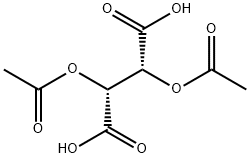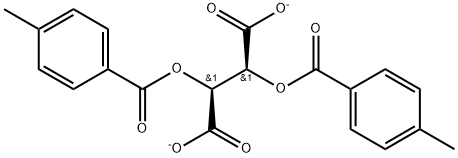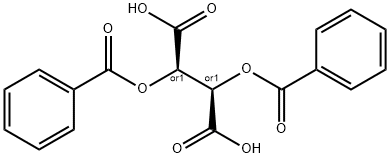(-)-DIACETYL-L-TARTARIC ACID
- CAS NO.:51591-38-9
- Empirical Formula: C8H10O8
- Molecular Weight: 234.16
- MDL number: MFCD00070579
- EINECS: 257-303-8
- SAFETY DATA SHEET (SDS)
- Update Date: 2023-06-08 17:06:39

What is (-)-DIACETYL-L-TARTARIC ACID?
The Uses of (-)-DIACETYL-L-TARTARIC ACID
(-)-Diacetyl-L-tartaric Acid is a derivative of L-Tartaric Acid (T007630), which is a naturally occurring chemical compound found in berries, grapes and various wines, and provides antioxidant properties and contributes to the sour taste within these products. (-)-Diacetyl-L-tartaric Acid has been studied in relation to wheat, dough additives and properties as an emulsifier.
What are the applications of Application
(?)-Diacetyl-L-tartaric Acid is a carboxylic acid for proteomics research
Properties of (-)-DIACETYL-L-TARTARIC ACID
| Melting point: | 120°C |
| Boiling point: | 398.9±42.0 °C(Predicted) |
| Density | 1.486±0.06 g/cm3(Predicted) |
| refractive index | -25 ° (C=10, Acetone) |
| storage temp. | Inert atmosphere,Room Temperature |
| solubility | almost transparency in Acetone |
| pka | 2.12±0.25(Predicted) |
| form | powder to crystal |
| color | White to Almost white |
Safety information for (-)-DIACETYL-L-TARTARIC ACID
| Signal word | Warning |
| Pictogram(s) |
 Exclamation Mark Irritant GHS07 |
| GHS Hazard Statements |
H315:Skin corrosion/irritation H319:Serious eye damage/eye irritation |
| Precautionary Statement Codes |
P264:Wash hands thoroughly after handling. P264:Wash skin thouroughly after handling. P280:Wear protective gloves/protective clothing/eye protection/face protection. |
Computed Descriptors for (-)-DIACETYL-L-TARTARIC ACID
New Products
4-Fluorophenylacetic acid 4-Methylphenylacetic acid N-Boc-D-alaninol N-BOC-D/L-ALANINOL Tert-butyl bis(2-chloroethyl)carbamate 3-Morpholino-1-(4-nitrophenyl)-5,6-dihydropyridin- 2(1H)-one Furan-2,5-Dicarboxylic Acid Tropic acid S-2-CHLORO PROPIONIC ACID ETHYL ISOCYANOACETATE 2-Bromo-1,3-Bis(Dimethylamino)Trimethinium Hexafluorophosphate (6-METHYL-[1,3]DITHIOLO[4,5-b]QUINOXALIN-2-ONE INDAZOLE-3-CARBOXYLIC ACID 4-IODO BENZOIC ACID (2-Hydroxyphenyl)acetonitrile 4-Bromopyrazole 5,6-Dimethoxyindanone 2-(Cyanocyclohexyl)acetic acid 4-methoxy-3,5-dinitropyridine 2-aminopropyl benzoate hydrochloride 1-(4-(aminomethyl)benzyl)urea hydrochloride diethyl 2-(2-((tertbutoxycarbonyl)amino) ethyl)malonate tert-butyl 4- (ureidomethyl)benzylcarbamate Ethyl-2-chloro((4-methoxyphenyl)hydrazono)acetateRelated products of tetrahydrofuran








You may like
-
 (-)-Diacetyl-L-tartaric Acid CAS 51591-38-9View Details
(-)-Diacetyl-L-tartaric Acid CAS 51591-38-9View Details
51591-38-9 -
 2033-24-1 98%View Details
2033-24-1 98%View Details
2033-24-1 -
 1975-50-4 98%View Details
1975-50-4 98%View Details
1975-50-4 -
 2-HYDROXY BENZYL ALCOHOL 98%View Details
2-HYDROXY BENZYL ALCOHOL 98%View Details
90-01-7 -
 2-Chloro-1,3-Bis(Dimethylamino)Trimethinium Hexafluorophosphate 221615-75-4 98%View Details
2-Chloro-1,3-Bis(Dimethylamino)Trimethinium Hexafluorophosphate 221615-75-4 98%View Details
221615-75-4 -
 61397-56-6 CIS BROMO BENZOATE 98%View Details
61397-56-6 CIS BROMO BENZOATE 98%View Details
61397-56-6 -
 14714-50-2 (2-Hydroxyphenyl)acetonitrile 98+View Details
14714-50-2 (2-Hydroxyphenyl)acetonitrile 98+View Details
14714-50-2 -
 118753-70-1 98+View Details
118753-70-1 98+View Details
118753-70-1
Statement: All products displayed on this website are only used for non medical purposes such as industrial applications or scientific research, and cannot be used for clinical diagnosis or treatment of humans or animals. They are not medicinal or edible.